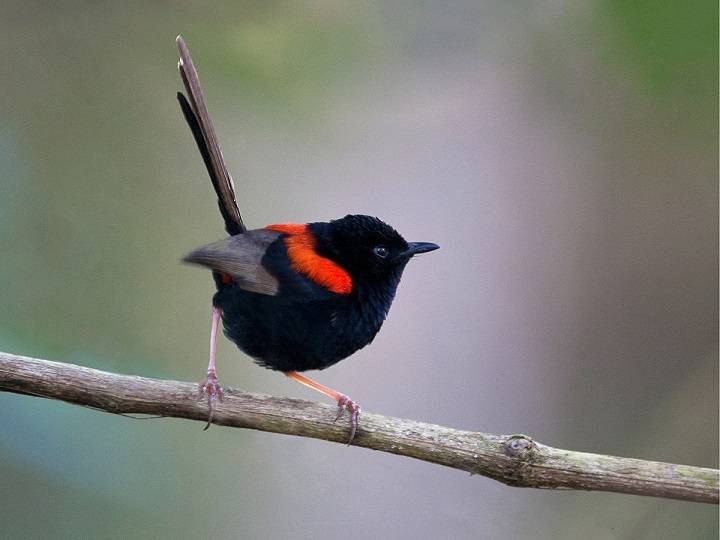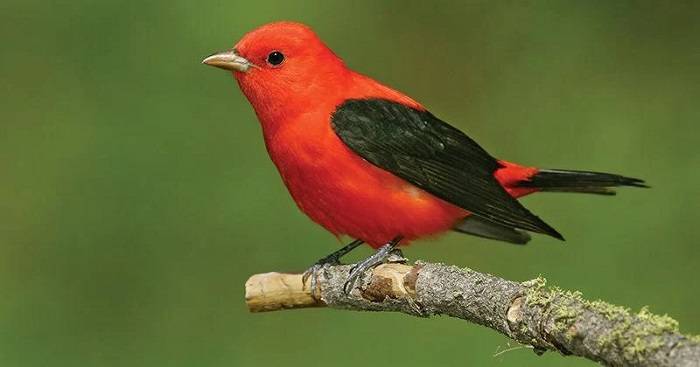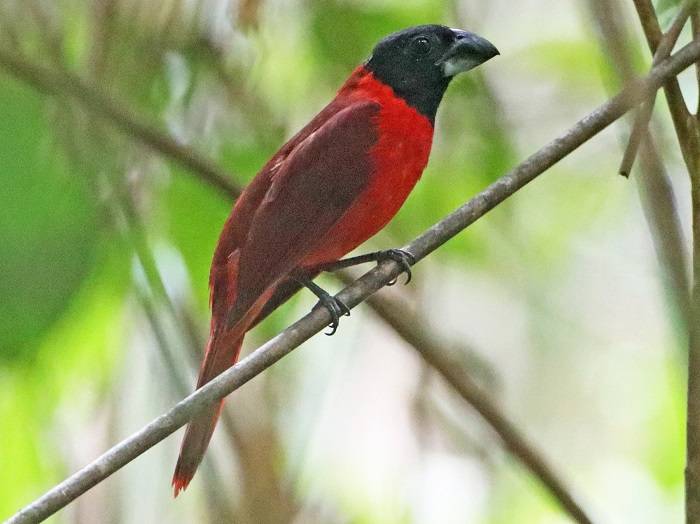In the vibrant tapestry of avian diversity, small black and red birds add a splash of color and charm to the natural landscape. With their striking plumage and lively personalities, these diminutive avian wonders captivate birdwatchers and nature enthusiasts alike. In this blog post, we embark on an exciting journey to discover the enchanting world of small black and red birds, exploring their unique characteristics, habitats, behaviors, and the fascinating role they play in ecosystems around the world.
Meet the Scarlet Tanager: A Jewel of the Forest Canopy
One of the most striking small black and red birds is the scarlet tanager (Piranga olivacea), a dazzling songbird that inhabits mature deciduous forests across North and South America. The male scarlet tanager boasts a brilliant scarlet plumage with contrasting black wings and tail, making it a standout presence among the verdant foliage of its forest habitat. Females, on the other hand, sport a more subdued olive-yellow plumage, providing effective camouflage while nesting and caring for their young.
Habitat and Behavior:
Scarlet tanagers are primarily found in mature deciduous forests with dense canopy cover, where they forage for insects, spiders, and fruits in the treetops. During the breeding season, males sing melodious songs from prominent perches to attract mates and establish territories. Despite their vibrant appearance, scarlet tanagers can be elusive and difficult to spot among the dense foliage, making them a sought-after sight for birdwatchers with keen eyes and attentive ears.
Conservation Status:
While scarlet tanagers are not currently considered threatened or endangered, they face habitat loss and fragmentation due to deforestation, urbanization, and climate change. Conservation efforts aimed at preserving and restoring mature forests and protecting critical migratory stopover sites are essential for ensuring the long-term survival of scarlet tanager populations and other forest-dependent species.
Discover the Flame-colored Tanager: A Gem of the Andean Cloud Forests
In the mist-shrouded cloud forests of the Andes Mountains, another small black and red bird awaits discovery: the flame-colored tanager (Piranga bidentata). With its fiery red plumage, jet-black wings, and distinctive white wing patches, the flame-colored tanager is a dazzling sight amidst the lush greenery of its montane habitat. These charismatic songbirds inhabit montane forests and elfin woodlands at elevations ranging from 1,500 to 3,500 meters, where they feed on insects, berries, and nectar from flowering plants.
Ecological Role:
Flame-colored tanagers play a crucial role in pollination and seed dispersal within the Andean cloud forest ecosystem. By feeding on fruits and nectar, these birds help to spread seeds and promote the growth of native plant species, contributing to the overall biodiversity and resilience of montane forests. Their vibrant plumage and melodious songs also attract ecotourists and birdwatchers to the cloud forests, generating economic benefits for local communities through nature-based tourism.
Conservation Challenges:
Like many montane species, flame-colored tanagers are vulnerable to habitat loss and climate change, which threaten the integrity of their cloud forest habitat. Deforestation, agricultural expansion, and mining activities pose immediate threats to the survival of flame-colored tanager populations, while rising temperatures and altered precipitation patterns disrupt the delicate balance of montane ecosystems. Conservation efforts focused on protecting key habitat areas, implementing sustainable land use practices, and mitigating the impacts of climate change are essential for safeguarding the future of flame-colored tanagers and their montane habitat.
Meet the Red-and-Black Grosbeak: A Jewel of Central and South America
In the tropical rainforests of Central and South America, another small black and red bird commands attention: the red-and-black grosbeak (Caryothraustes erythromelas). With its striking black and red plumage, stout bill, and distinctive vocalizations, the red-and-black grosbeak is a charismatic inhabitant of lowland forests, secondary growth, and forest edges. These colorful songbirds feed on a variety of fruits, seeds, and insects, using their powerful bills to crack open tough seed pods and extract nutritious kernels.
Role in Ecosystems:
Red-and-black grosbeaks play a vital role in seed dispersal and forest regeneration within their tropical rainforest habitat. By consuming fruits and seeds from a wide range of plant species, these birds help to disperse seeds over long distances, promoting genetic diversity and facilitating the regeneration of disturbed areas. Their presence also serves as an indicator of habitat quality and ecosystem health, making them valuable subjects for ecological monitoring and conservation efforts.
Small Black and Red Birds
Despite their ecological importance, red-and-black grosbeaks face numerous threats to their survival, including deforestation, habitat fragmentation, and illegal trapping for the pet trade. Conservation initiatives aimed at protecting and restoring tropical rainforest habitats, establishing protected areas, and combating illegal wildlife trade are essential for ensuring the long-term viability of red-and-black grosbeak populations and other biodiversity hotspots in Central and South America.
Related Post:
Exploring the Fascinating World of Male, Female, and Male Muscovy Ducks
Unveiling the Spectrum of Colored Duck Eggs: Nature’s Palette of Surprises
Unlocking the Secrets of Duck Hatching: From Egg to Duckling
Small black and red birds enrich our world with their vibrant colors, melodious songs, and vital ecological roles. From the scarlet tanager of North America to the flame-colored tanager of the Andean cloud forests and the red-and-black grosbeak of Central and South America, these charismatic songbirds inspire awe and admiration wherever they are found. By understanding the unique characteristics, habitats, and conservation challenges facing small black and red birds, we can work together to protect and preserve these avian jewels for future generations to enjoy. So the next time you venture into the forest or gaze up at the canopy, keep an eye out for these dazzling creatures and marvel at the wonders of nature’s diversity.




